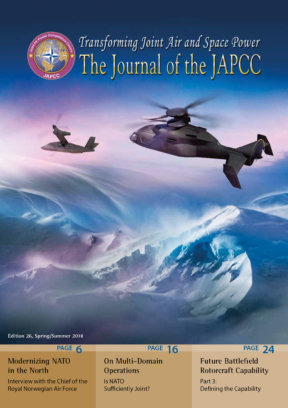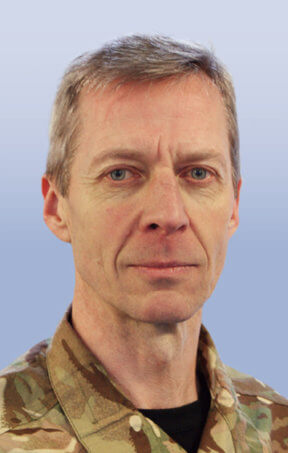‘Coming together is a beginning, staying together is progress, and working together is success.’
Henry Ford
Interoperability – What is the Problem?
Darts and golf are sports played by individuals. Most able-bodied darts or golf players would agree that the process runs more smoothly if they perform the motions on their own, rather than being tied up by someone else trying to help. Military operations are in stark contrast: by their nature, they can only be successful when people work together. Although military personnel may have something to learn from darts players, golfers and others in terms of individual skills, in military operations it is the synergies, force multipliers and cooperation that make the big difference. This principle was realized by the early armies of long ago and remains a fundamental part of military operations today at all command levels. The principle applies just as much when entirely separate military organizations must work together, a business that is commonly referred to as ‘interoperability’, which NATO defines as ‘the ability for Allies to act together coherently, effectively and efficiently to achieve tactical, operational and strategic objectives’.1
This is familiar territory for military organizations, yet when forces from different nations have to cooperate there can be a marked difference between the ‘principle’ of interoperability and what can be put into practise. In multinational operations, various barriers tend to emerge that inhibit the interaction necessary to enable participants to work properly together.
Examples of these barriers will be recognizable in most organizations: prioritizing national business first, resource limitations, organizational policies, national policies, technical differences, security caveats, language differences and so on. Many organizations are working to overcome these barriers, but turning ambition into results is a tough business. As an example of an allied organization working to produce solutions for interoperability, this article explains the work of the European Air Group (EAG) and its perspective on addressing the challenges for interoperability. In today’s rapidly changing and increasingly complex world, interoperability is not a matter that can be sufficiently addressed by focussed, case-by-case agreements. Instead, it will increasingly depend on the ability of allies to act collectively and decisively, when and where required, across a spectrum of activities. In short, there is a compelling need to interoperate.
Pulling the Strings Together
When France and the UK founded the ‘Franco-British European Air Group’ in 1995, they did so because the air forces of both nations realized that to conduct operations together successfully, they first had to prepare together. They recognized that ‘preparation’ did not just rely on high level agreements, but also depended on cooperation between organizations at the grass roots level, in terms of knowledge, tactics and procedures. What was needed was a new organization that could bring operators together and produce tangible results, to improve their cohesion.
The Franco-British initiative gained momentum and in 1998 it formed the basis for establishing the EAG, an organization underpinned by an Intergovernmental Agreement between its seven Member Nations: Belgium, France, Germany, Italy, the Netherlands, Spain and the United Kingdom. The EAG’s purpose is to ‘improve the operational capabilities of the Parties’ Air Forces to carry out operations in pursuit of shared interests, primarily through mechanisms which enhance interoperability’.2
The EAG is an example of how interoperability between air forces can be significantly improved if they collaborate in training and exercises, share capabilities and develop common tactics, techniques, procedures and doctrine. A key component for success is the ability of the participants to pinpoint the areas in which the greatest value can be added. This task is not as straightforward as it might at first appear: general subject matter may be easy to name, for example: ‘cyber’, but identifying the specific areas that need to be worked on, agreeing on common visions of the way forward and then transforming these into some form of output that personnel and organizations can put into practise, is another matter.
As an organization, the EAG has been established to address these very issues and engage primarily at tactical and operational levels, placing an emphasis on delivering results that can quickly be put into action. During its existence, it has generated numerous beneficial projects across the air power spectrum, such as enabling better interoperability between fighter aircraft, in air transport operations, logistics, communications, force protection, personnel recovery, aviation medicine and much more.
By identifying gaps, issues and opportunities, and then developing solutions, the EAG today manages more than twenty multinational interoperability projects across four domains, including air operations, force protection, logistics and CIS/Cyber. The outputs range from standard operating procedures to internet-based information platforms, collaborative forums, high-level Technical Arrangements, an advanced training and exercises masterplan, and the long-running exercise series conducted under the umbrella title of ‘VOLCANEX’. This work has also been the catalyst for initiatives that have grown to a substantial scale, such as the European Joint Personnel Recovery Centre at Poggio Renatico Air Base in Italy and the European Air Transport Command based at Eindhoven Airbase in the Netherlands.
Core Business
Every organization must operate within limited resources and the EAG is no exception. Although a vast number of subjects could potentially be engaged, the list of what can be worked on and achieved has to be assembled realistically. However, by combining inputs from the Member air forces and coordinating activities with partner organizations, the opportunities to improve interoperability can be identified, agreed, shared, developed and implemented effectively.
In the EAG’s case, its work is enabled by a centrally located Headquarters containing a multinational permanent staff based at Royal Air Force High Wycombe in the UK. It is important to stress that the EAG is a collective organization comprising seven air forces and not just a Headquarters, which works on behalf of its Members. In order to function, the EAG draws on expertise from its Members and from partner organizations, including the Joint Air Power Competence Centre (JAPCC), NATO Allied Air Command, European Defence Agency, Tactical Leadership Programme, United States Air Forces in Europe (USAFE) and others. This ‘networked’ approach to the EAG’s work provides structure for developing interoperability tools, in a way that supports the needs of all stakeholders and exploits synergies, coordinates activities and avoids duplication. Furthermore there is a conscious awareness that the EAG Member Nations are also members of NATO. Therefore, it is of great importance to ensure that EAG work is aligned with NATO standards and practises, and also harmonized with other organizations, where applicable.
Impact of the Fifth-Generation
‘Let our advance worrying become our advance thinking and planning.’
Winston Churchill
Today, the exponential advances in technology and its availability are fundamentally impacting the air domain. Typical of these advances is the introduction of ‘fifth-generation’ systems, which embrace technological leaps forward in terms of stealth, situational awareness, communications and other factors, and also mark a fundamental shift in emphasis from ‘air superiority’ to ‘information superiority’. The arrival of the ‘fifth-generation’ opens up new ways of operating for military organizations. However, this prospect does not come without its problems. It is no good trying to operate a versatile new air system that has a stunning capacity to handle information, if it cannot communicate, operate or be understood by people and systems that it has to interact with. In order for fifth-generation capabilities to be exploited, they must be recognized and interoperable with existing systems in the technological, procedural and human domains. In the short to medium term, the challenge for many air forces will be how to integrate the bulk of their existing ‘fourth-generation’ systems, with new fifth-generation technologies – and vice versa.
In 2016, the EAG Steering Group tasked the EAG Permanent Staff to find solutions to these issues. Since then, the EAG has worked together with its Members and partners to develop what is now called the ‘Combined Air Interoperability Programme’, or ‘CAIP’. The CAIP, which was formally launched in July 2017, seeks to resolve the issues that result from integrating fourth- and fifth-generation weapon systems to achieve a higher level of interoperability in future combined air operations.
The CAIP is both a vehicle for identifying future interoperability challenges and a structured approach to resolving them. It envisages a long-term goal for 2030+, but it is driven by a more immediate, intermediate goal for 2022 that defines achievable criteria for fourth-/fifth-generation interoperability. Using the 2022 goal as the immediate target, the challenges that need to be overcome have been identified, objectives established and roadmaps developed in order to address each challenge. Although the EAG has led the development of the CAIP, the work involved will not all be EAG business. Collaboration is underway with NATO Allied Air Command, the JAPCC, USAFE and other organizations to address some challenges identified by the CAIP, where these can be more appropriately handled by other organizations. The CAIP is therefore a focal point for activities that involve multiple organizations, all of which will contribute to achieving the EAG’s 2022 intermediate goal for multinational, fourth-/fifth-generation interoperability.
The Road Ahead
This year the EAG celebrates its Twentieth Anniversary, having first been established in its current form in 1998. Today, the global context in which the EAG and its partners must operate is changing on an unprecedented scale. In an evolving political, social, technological, economic and security environment, new opportunities and challenges are appearing from unexpected angles. New frontiers and potential battlegrounds are also emerging, and once unfamiliar terms such as ‘cyber attacks’, ‘fake news’, ‘non-state actors’ and others have become common language. For every military organization, remaining static will not be a survivable option. To counter the diversity and proliferation of new threats, the development and employment of systems are becoming more complex, and costs are increasing. Therefore, the need for allies to be able to act together – to interoperate – is more vital than ever.
A key challenge for interoperability will be to make sure that principles are put into practise. This, in turn, will depend on the participants committing the time and effort to bring together assets, procedures and, crucially, personnel. These central factors will determine whether or not allies will truly be able to function, not just collectively but also decisively, whenever, however, and wherever this may be required.
The EAG has traditionally adopted a tactical and operation focus, but the effect of such work can be strategic. A central component for interoperability going forward will involve positive and sustained momentum for collaboration from the organizations involved – which means that the sharing of ideas, networking and communication between them will be essential. This requirement poses other questions: just what information can be shared and what cannot? Where does multinational ‘interoperability’ really sit on the list of priorities? How will we really put this new stuff into practise? While it may not be possible to overcome all of these issues, a coordinated, targeted approach to breaking down barriers at key points can certainly produce results.
For the EAG, the development of the CAIP as part of its core business is an example of a way forward in a specific domain that can benefit both its Member nations and its partners. Using this methodology, it may also be feasible to examine ways of achieving interoperability in other environments, in which synergies can enable allies to stay ahead of the threats. All of this is achievable, but collective success will depend on three factors: the willingness to move forward together, the commitment to do so, and – that most essential of components – trust.












